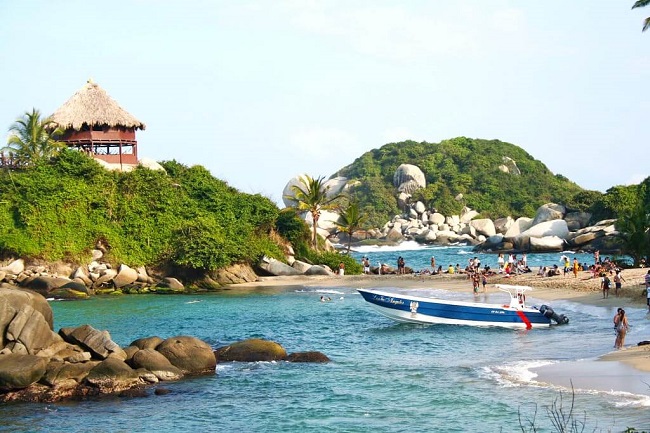Parque Nacional Natural Tayrona, located on Colombia’s Caribbean coast, is a stunning amalgamation of beaches, jungles, and rich biodiversity. It’s a haven for nature enthusiasts, offering a range of activities like hiking, bird-watching, and snorkeling.

Best Guide to Visit Parque Nacional Natural Tayrona
In this comprehensive guide, we present the best 10 guides to visiting Parque Nacional Natural Tayrona and making the most of your time in this breathtaking natural setting.
1. When to Visit Parque Nacional Natural Tayrona
The best time to explore the park is between December and April, during the dry season. This period offers optimal weather conditions for hiking and water-based activities.
The park closes for a month each year for ecological restoration, usually in September, so it’s crucial to check for updates before planning your trip.
2. How to Get There
The nearest city to Tayrona is Santa Marta, accessible by air and land. From Santa Marta, you can reach the park by bus or taxi, a journey that typically takes about an hour. You’ll enter the park at one of its main entrances, like El Zaino or Calabazo.
3. Entrance Fees and Permits
There are entrance fees for both Colombian residents and foreign tourists. It’s advisable to purchase tickets in advance, especially during peak seasons. Remember that you may also require a Yellow Fever vaccination certificate to enter certain areas of the park.
4. Choose Your Trails Wisely
Tayrona offers several hiking trails with varying levels of difficulty. Popular routes include the one to Cabo San Juan, a 2-hour hike that takes you through jungles and pristine beaches. Each trail offers its own unique ecosystem and breathtaking views.
5. Accommodation Inside the Park
You’ll find a variety of accommodation options inside the park, from eco-habs to basic hammocks. It’s advisable to book in advance, especially during peak season. Some popular options include Ecohabs Tayrona and the hammocks at Cabo San Juan.
6. Exploring the Beaches
The beaches within Tayrona are among the park’s top attractions. Whether it’s the popular Cabo San Juan or the secluded Playa Nudista, you’ll find a beach that matches your vibe. Note that swimming is not allowed at some beaches due to strong currents.
7. Wildlife and Bird Watching
The park is home to a variety of flora and fauna, including howler monkeys and hundreds of bird species. For avid bird watchers, the El Pueblito trail offers an excellent opportunity to spot native and migratory birds.
8. Snorkeling and Scuba Diving
Tayrona also offers fantastic snorkeling and scuba diving opportunities, especially around La Piscina beach. Gear can be rented from dive shops, and guided tours are also available for those new to underwater exploration.
9. What to Pack
Essentials include lightweight clothing, waterproof boots for hiking, swimsuits, and snorkeling gear if you prefer your own. Don’t forget sunblock, insect repellent, and reusable water bottles to stay hydrated.
10. Cultural Etiquette and Indigenous Communities
The park is home to indigenous communities like the Kogi and Wiwa. If you happen to cross paths, it’s crucial to respect their customs and privacy. Do not photograph them without permission and maintain a respectful distance.
11. Gastronomic Experiences in and Around Tayrona
While the park itself offers basic food options at its main campsites, the gastronomic experiences lie in the nearby towns and settlements.
Local restaurants around the entrance areas serve traditional Colombian fare, including arepas, fresh seafood, and tropical fruit juices. Trying local dishes enhances your cultural experience and adds another layer to your Tayrona visit.
12. Health and Safety Precautions
Before embarking on your Tayrona adventure, it’s wise to take some health precautions. As mentioned earlier, a Yellow Fever vaccination may be required, and it’s advisable to be up-to-date on routine vaccines.
In addition, carry a basic first aid kit, and be aware of the park’s emergency protocols. Although Tayrona is generally safe, it’s always better to be prepared for unexpected situations.
Additional Tips for Responsible Tourism
Practicing responsible tourism is key to preserving Tayrona’s natural beauty for future generations. Stick to designated paths, carry back all your trash, and refrain from picking plants or disturbing wildlife. Your responsible conduct ensures that the park remains a sanctuary for all.
Conclusion
Parque Nacional Natural Tayrona is more than just a tourist destination; it’s a biodiversity hotspot and a sacred space for indigenous communities. From its awe-inspiring trails to its diverse flora and fauna, the park offers a deeply enriching experience.
This best guide to visit Parque Nacional Natural Tayrona is designed to help you explore this natural wonder in the most fulfilling way possible. So, pack your bags and set off on an adventure that promises to be unforgettable.